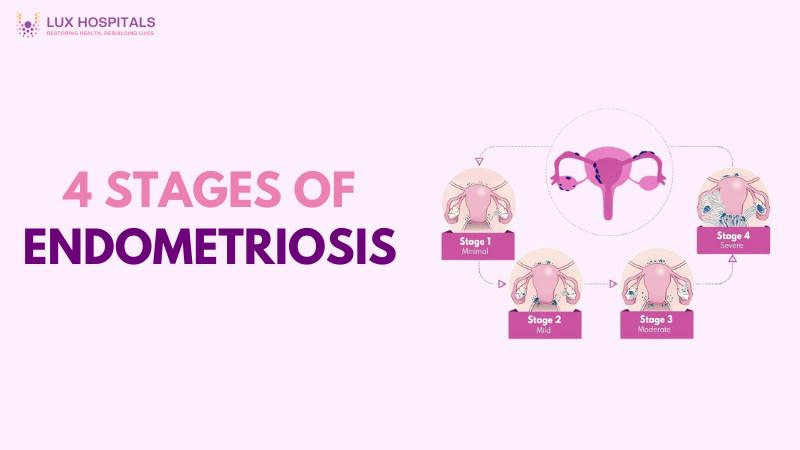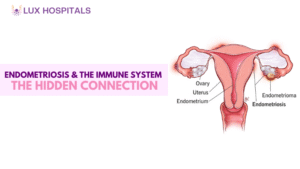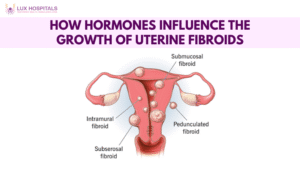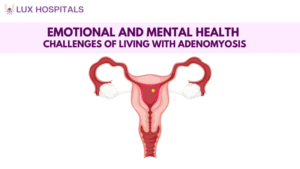Understanding the 4 Stages of Endometriosis: Symptoms and Treatment

Endometriosis is a chronic condition that affects millions of women globally, yet it often goes undiagnosed or misunderstood. Endometriosis is characterized by the development of tissue outside the uterus that mimics the uterine lining , This may result in infertility and other unpleasant consequences.
One of the most critical aspects of understanding this condition is recognizing the Stages of Endometriosis, which help doctors assess its severity and guide effective treatment options. This blog will explore each stage’s meaning, symptoms, and available endometriosis treatment options.
What are the 4 Stages of Endometriosis?
The American Reproductive Medicine Society (ASRM) assigns grades to the stages of endometriosis. The stages (1 to 4) are according to a variety of factors, including the site, size, and depth of implants and the degree of scar tissue (adhesions) on the laparoscopy performed to diagnose.
It is important to note that the severity of an individual’s symptoms can vary with the stages of endometriosis. A woman with stage 1 endometriosis, for example, may experience crippling symptoms, while a woman with stage 4 endometriosis may only experience mild symptoms.
Stage 1 Endometriosis: Minimal
In stage 1 endometriosis, only a few small lesions or implants are found. There are typically no significant adhesions or scar tissue, and the lesions are often shallow.
Symptoms of Stage 1 Endometriosis
- Mild pelvic pain
- Occasional cramping before or during periods
- Possible pain during intercourse
This early stage can often go unnoticed or be mistaken for normal menstrual discomfort. However, if you’re consistently experiencing pelvic pain or unusual periods, it’s worth consulting a gynecologist.
Stage 2 Endometriosis: Mild
Stage 2 endometriosis involves more lesions than stage 1. The implants may be deeper and have a small amount of scar tissue.
Symptoms of Stage 2 Endometriosis
- Pelvic pain that worsens during menstruation
- Increased pain during intercourse
- mild digestive issues like constipation or bloating
Symptoms become more noticeable at this stage and may interfere with daily activities.
Stage 3 Endometriosis: Moderate
Lesions are more profound and widespread in stage 3 endometriosis. Ovarian endometriomas (“chocolate cysts”) may be present, and scar tissue may start forming between pelvic organs.
Symptoms of Stage 3 Endometriosis
- Chronic pelvic pain
- Heavy menstrual bleeding
- Pain during or after sex
- Infertility
- Fatigue and digestive issues
Many women are diagnosed at this stage when they seek help for fertility issues. Endometriosis stages symptoms like persistent pain and hormonal imbalances, become more intense.
Stage 4 Endometriosis: Severe
Stage 4 endometriosis is the most advanced stage. It involves widespread big cysts on one or both ovaries, deep implants, and a lot of scar tissue that can bind organs together.
Symptoms of Stage 4 Endometriosis
- Severe and constant pelvic pain
- Painful bowel movements or urination
- Debilitating menstrual cramps
- Infertility
- Significant fatigue
This stage often requires a more aggressive and multidisciplinary treatment approach. Women with stage 4 endometriosis may also experience symptoms that affect their bladder and bowels.
Diagnosing the Stages of Endometriosis
Diagnosis is typically made by laparoscopy, a minimally invasive procedure by which physicians can see the pelvic organs and determine the degree of the disease. Imaging tests like MRIs and ultrasounds can be helpful, but they tend not to pick up small or occult lesions.
Endometriosis Treatment Options by Stage
Endometriosis treatment is tailored to the individual’s symptoms, the stage of the disease, and personal goals such as preserving fertility. Here’s a general breakdown of treatment approaches:
For Stage 1 and Stage 2 Endometriosis:
- Hormonal therapy (birth control pills, Gnrh agonists)
- Pain management (NSAIDS)
- Lifestyle changes (diet, exercise, stress reduction)
- Laparoscopic surgery to remove small lesions if symptoms persist
For Stage 3 and Stage 4 Endometriosis:
- Advanced laparoscopic or robotic surgery to remove deep lesions and scar tissue
- Fertility treatments like IVF are used if conception is complex.
- Hormonal suppression therapy
- Multidisciplinary care, involving gynaecologists, gastroenterologists, and pain specialists
Although it is usually a last resort, a hysterectomy may be undertaken in extreme instances.
Living with Endometriosis
Treating endometriosis is more than curing physical pain. Psychological effect can be significant, particularly if you experience chronic pain or infertility. Open discussion with your doctor, support from support groups, and All forms of therapy can make a big difference. Pain can be lessened with easy self-care techniques including regular exercise, a healthy diet, and heat.
Conclusion
Understanding the Stages of Endometriosis is crucial for recognizing how the condition progresses and what the options for treatment are. Even though it can be a fatal illness, prompt medical attention, individualized care, and ongoing support can significantly improve quality of life. Never be afraid to ask for professional help if you are experiencing symptoms or are worried. Relief is on the way, and you’re not alone.
FAQS
Can endometriosis cause infertility at all stages?
Can you have severe symptoms in the early stages of endometriosis?
What is the most effective endometriosis treatment?
Is stage 2 endometriosis severe?
How is the stage of endometriosis diagnosed?
Can endometriosis come back after treatment?
Does Stage Always Match Pain Levels?
Frequently Asked Questions
Yes, endometriosis can affect fertility at any stage, but the risk increases with severity. Stage 3 and stage 4 endometriosis are more commonly associated with fertility issues.
Yes, endometriosis stages’ symptoms don’t always match the stage. Even stage 1 endometriosis can cause intense pain, while some women with stage 4 endometriosis might experience mild discomfort.
Endometriosis treatment depends on the stage and symptoms. Options include pain relief medications, hormonal therapy, and surgery. For advanced stages like stage 3 endometriosis or stage 4, laparoscopic surgery may be recommended.
Stage 2 endometriosis is considered mild, but it can still cause significant pain and impact fertility. Early treatment helps prevent progression to more advanced stages.
The only definitive way to determine the stage of endometriosis is through laparoscopy a minimally invasive surgery that allows direct visualization of the lesions and scar tissue.
Yes, recurrence is possible, especially if the lesion isn’t removed during surgery. Hormonal therapy post-surgery may help reduce the chances of recurrence.
Not necessarily. The most frequently misinterpreted feature of endometriosis is that the stages bear no relation to the severity of pain. A stage 1 woman might be suffering horrible pain, whereas a stage 3 or 4 woman will hardly notice anything. This unpredictability is why diagnosis and treatment early on are so important, stage or no stage.




















